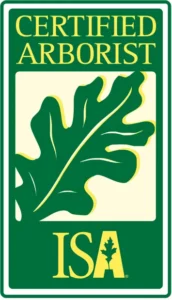Trees are an essential part of Wisconsin’s landscape, providing shade, beauty, and environmental benefits. However, like all living organisms, trees are susceptible to diseases and pests that can weaken them, reduce their lifespan, or even lead to their death if left untreated. Knowing how to spot common tree problems early can help you take action to protect your trees and your property.
-
Dutch Elm Disease
Symptoms: Wilting leaves that turn yellow and brown, often starting on one branch and spreading throughout the tree.
Cause: A fungal infection spread by bark beetles or root grafts between trees.
Treatment: Prune affected branches promptly and dispose of them properly. In some cases, fungicide injections may help. -
Oak Wilt
Symptoms: Leaves wilt, turn dull green or bronze, and fall prematurely, often starting at the top of the tree.
Cause: A fungal disease spread through root systems or by beetles attracted to fresh wounds.
Treatment: Avoid pruning oaks during the growing season. Professional treatment may include fungicides or trenching to sever root connections. -
Apple Scab
Symptoms: Dark, scabby lesions on leaves and fruit. Leaves may turn yellow and fall prematurely.
Cause: A fungal disease that thrives in wet, humid conditions.
Treatment: Rake and dispose of infected leaves to prevent the spread. Fungicide sprays can be applied in early spring. -
Emerald Ash Borer Infestation
Symptoms: Canopy thinning, D-shaped exit holes in the bark, and increased woodpecker activity.
Cause: A non-native insect that feeds on ash trees, disrupting their ability to transport water and nutrients.
Treatment: Early detection is key. Treatment options include insecticides or, in severe cases, tree removal. -
Magnolia Scale
Symptoms: Sticky sap (honeydew) on leaves or branches, sooty mold growth, and weakened, yellowing foliage.
Cause: A soft-scale insect that feeds on sap, reducing the tree’s vigor and leaving behind honeydew that attracts mold.
Treatment: Horticultural oils and insecticidal sprays can be applied in late summer to early fall. Heavy infestations may require multiple treatments or professional care. -
Needlecast
Symptoms: Needles on pines and spruces turn brown, yellow, or purple and eventually fall off, leaving bare lower branches.
Cause: A fungal disease that spreads in wet, humid conditions and infects needles through water splashes.
Treatment: Prune and remove affected branches to improve air circulation. Apply appropriate fungicides in early spring to prevent further infections. -
Chestnut Borer
Symptoms: Wilting or dying branches, increased woodpecker activity, and small exit holes in the bark.
Cause: A native beetle that attacks stressed or injured oak and chestnut trees by tunneling through the wood and disrupting nutrient flow.
Treatment: Maintain tree health through regular watering and proper pruning. Severely infested trees may need removal to prevent further spread. -
Gypsy Moth
Symptoms: Defoliation from caterpillar feeding, leading to reduced vigor and susceptibility to other stressors.
Cause: Gypsy moth caterpillars feed on the foliage of numerous tree species, including oaks, birches, and aspens.
Treatment: Remove egg masses in late fall or early spring. Biological insecticides, like Bt, can be applied to manage caterpillar populations. For severe infestations, consult with a certified arborist for treatment options.
How to Protect Your Trees
- Regular Inspections: Check your trees for signs of disease or pests at least once a season.
- Proper Pruning: Avoid unnecessary wounds that can invite pathogens or attract insects.
- Professional Care: Work with a certified arborist to diagnose and treat tree problems effectively.
- Healthy Practices: Water and mulch trees properly to keep them stress-free and resilient.
Tree diseases and pests can be managed or prevented with the right care and attention. If you suspect one of your trees may be at risk, don’t hesitate to reach out to the experts at Tree Wise Men LLC. We’re here to help keep your trees healthy and thriving!
Would you like to schedule a tree health assessment? Contact us today!


















